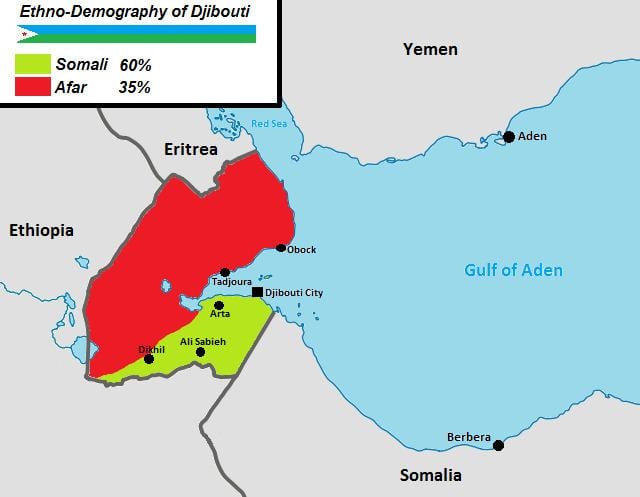Population 810,178 (2014) Life expectancy 62.4 years (2014) | Growth rate 2.23% (2014) | |
 | ||
Birth rate 25.27 births/1,000 population (2011 est.) Death rate 8.23 deaths/1,000 population (July 2011 est.) Fertility rate 2.79 children born/woman (2010) | ||
This article is about the demographics of Djibouti, including population density, ethnicity, education level, health, economic status, religious affiliations and other aspects of the population.
Contents
- Map of Djibouti
- Ethnic groups
- Languages
- Population
- Projections
- Vital statistics
- Demographic statistics
- Median age
- Population growth rate
- Urbanization
- Major cities population
- Sex ratio
- Life expectancy at birth
- HIVAIDS
- Major infectious diseases
- Nationality
- Religions
- Literacy
- References
Map of Djibouti
Ethnic groups
Djibouti is a multiethnic country. As of 2015, it has a population of around 846,687 inhabitants. Djibouti's population grew rapidly during the latter half of the 20th century, increasing from about 62,000 in 1950 to 889,000 by 2010.
The two largest ethnic groups are the Somali (60%) and the Afar (35%). The Somali clan component is mainly composed of the Issas, a sub-clan of the larger Dir. The remaining 5% of Djibouti's population primarily consists of Arabs, Ethiopians and Europeans (French and Italians). Approximately 76% of local residents are urban dwellers; the remainder are pastoralists.
Languages
Djibouti is a multilingual nation. The majority of local residents speak Somali (524,000 speakers) and Afar (306,000 speakers) as a first language. These idioms are the mother tongues of the Somali and Afar ethnic groups, respectively. Both languages belong to the larger Afroasiatic family. There are two official languages in Djibouti: Arabic (Afroasiatic) and French (Indo-European).
Arabic is of social, cultural and religious importance. In formal settings, it consists of Modern Standard Arabic. Colloquially, about 59,000 local residents speak the Ta'izzi-Adeni Arabic dialect, also known as Djibouti Arabic. French serves as a statutory national language. It was inherited from the colonial period, and is the primary language of instruction. Around 17,000 Djiboutians speak it as a first language. Immigrant languages include Omani Arabic (38,900 speakers), Amharic (1,400 speakers), Greek (1,000 speakers) and Hindi (600 speakers).
Population
According to the 2010 revision of the UN's World Population Prospects, the total population was 889,000 in 2010 compared to 62,000 in 1950. The proportion of children below the age of 15 in 2010 was 35.8%, 60.9% was between 15 and 65 years of age, while 3.3% was 65 years or older.
Projections
The following are UN medium variant projections; numbers are in thousands:
Vital statistics
Registration of vital events in Djibouti is incomplete. The Population Department of the United Nations prepared the following estimates.
Births and deaths
Demographic statistics
The following demographic statistics are from the CIA World Factbook, unless otherwise indicated.
Population
828,324 (July 2015 est.)Median age
Total: 22.8 years
Male: 21.1 years
Female: 24.1 years (2014 est.)
Population growth rate
2.23% (2014 est.)Urbanization
urban population: 77.1% of total population (2011)rate of urbanization: 1.96% annual rate of change (2010-15 est.)Major cities - population
DJIBOUTI (capital) 529,000 (2015)Sex ratio
at birth: 1.03 male(s)/femaleunder 15 years: 1 male(s)/female15-24 years: 0.89 male(s)/female25-54 years: 0.71 male(s)/female55-64 years: 0.85 male(s)/female65 years and over: 0.82 male(s)/femaletotal population: 0.86 male(s)/female (2014 est.)Life expectancy at birth
Total population: 62.4 years
Male: 59.93 years
Female: 64.94 years (2014 est.)
HIV/AIDS
adult prevalence rate: 1.2% (2012 est.)people living with HIV/AIDS: 7,700 (2012 est.)deaths: 800 (2012 est.)Major infectious diseases
degree of risk: highfood or waterborne diseases: bacterial and protozoal diarrhea, hepatitis A, and typhoid fevervectorborne disease: dengue fevernote: highly pathogenic H5N1 avian influenza has been identified in this country; it poses a negligible risk with extremely rare cases possible among US citizens who have close contact with birds (2013)
Nationality
Djiboutien or DjiboutianEthnic groups
Somali 60%, Afar 35%, French and Italians, Arab, Ethiopian 5%
Religions
The religious adherents of Djibouti are:
Muslim 94%Christian 6%Languages
The languages of Djibouti are:
French (official)Arabic (official)SomaliAfar